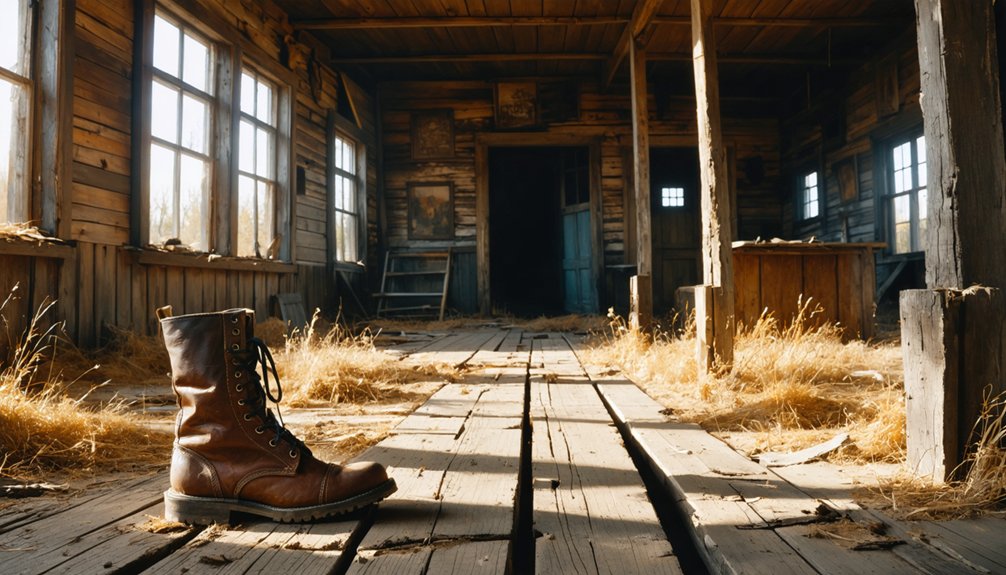You’ll discover Silver City‘s remnants nestled in South Dakota’s Black Hills, where the Gorman brothers established their mining settlement in 1876. The town quickly grew to 300 residents, centered around the Diana Lode and Lady of the Hills mines. Though the silver boom faded by the early 1900s, you can still explore the historic structures and Pactola Lake recreation area. The town’s rich mining heritage holds countless stories within its weathered walls.
Key Takeaways
- Silver City transformed from a bustling 1870s mining boomtown with over 300 residents into a ghost town following mining decline.
- The town’s fate was sealed by low-grade ore deposits and the Mystic Reduction Mill’s failure in 1913.
- Railroad discontinuation and the Great Depression dealt final blows to Silver City’s mining economy and population.
- Original structures, including the Catholic church and general store, stand as remnants of the town’s prosperous mining era.
- The ghost town now serves as a tourist destination near Pactola Lake, preserving Black Hills mining history.
The Gorman Brothers’ Vision
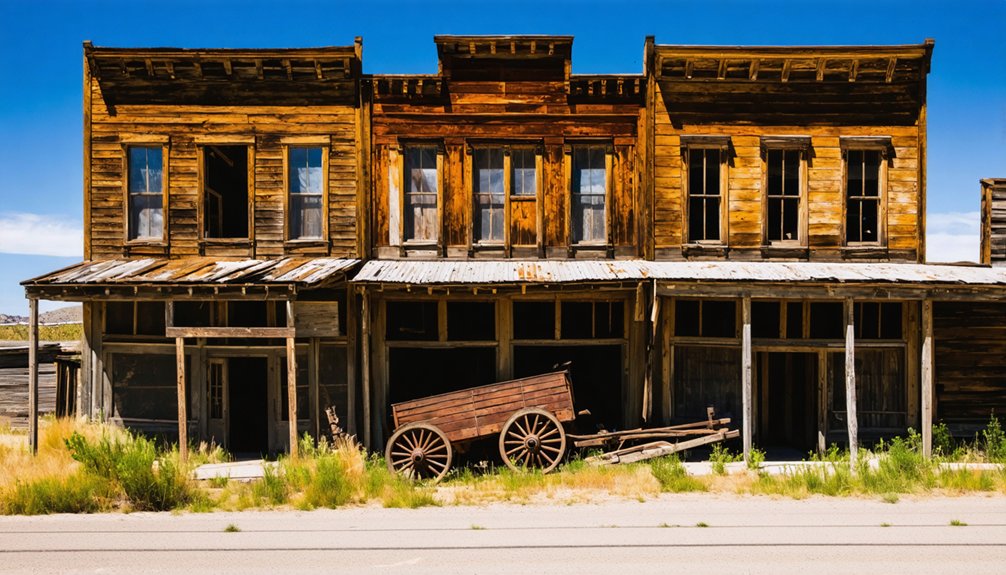
When the Gorman brothers arrived from Canada in 1876, they brought more than just mining equipment to the Black Hills – they carried a grand vision for Silver City’s future.
The Gorman brothers’ ambitions centered on transforming Camp Gorman, as it was first known, into a thriving mining community development that would support hundreds of residents by 1878.
Situated in the western edge of South Dakota, the location proved ideal for their mining ventures.
You can trace their strategic planning through the establishment of their two primary mines – the Diana Lode and The Lady of the Hills.
Their vision wasn’t limited to mining; they understood that a successful town needed infrastructure. They spearheaded the creation of essential services, including a general store, hotel, sawmills, and eventually a post office, school, and church.
The brothers’ foresight laid the groundwork for Silver City’s rapid growth and economic diversification. In 1910, John Gorman made the pivotal decision to put all their mine holdings up for sale, marking the end of their pioneering era in Silver City.
From Camp Gorman to Silver City
You’ll find Camp Gorman’s transformation into Silver City marked a pivotal shift from humble prospecting camp to established mining town.
As surveyors platted the settlement and its population swelled beyond 300 by 1878, you’d notice how the community’s silver-focused economy shaped its new identity.
The name change reflected your town’s evolution from the Gorman brothers’ initial vision into a proper Black Hills boomtown, complete with expanded infrastructure and a growing network of mines like the Diana Lode and Lady of the Hills. Similar to other mining boomtowns nearby, such as Deadwood and Lead, Silver City experienced rapid growth during its early years. The town’s development accelerated with the construction of the first smelter in 1877, known as the McDonald Smelter.
Early Settlement Origins
The discovery of precious metals in the Black Hills during 1876 drew Canadian prospectors known as the Gorman brothers to establish what would become Silver City, South Dakota.
You’ll find the Gorman brothers’ impact was immediate and lasting – they founded two significant mines, the Diana Lode and The Lady of the Hills, which became the backbone of the local economy.
Their early mining techniques focused on working silver-lead veins through surface claims and underground shafts.
What started as Camp Gorman, a simple mining settlement, quickly grew into a bustling community along the Western Railroad.
The town’s success attracted numerous settlers, reaching over 300 residents by 1878.
Years later, during the Great Depression, the area saw renewed activity when Camp Pactola F-4 was established nearby in 1933, providing jobs and infrastructure development to the region.
Name Change Evolution
As Silver City grew from its humble beginnings, its identity underwent a notable shift in name – starting as Camp Gorman in honor of the founding Canadian brothers.
You’ll find that naming conventions in the Black Hills region typically followed a pattern: camps first honored their founders before adopting names that reflected their primary resources.
Between 1876 and 1878, as the population swelled to over 300 residents, the settlement’s historical significance evolved beyond just the Gorman brothers’ mining ventures.
The change from Camp Gorman to Silver City marked more than just a name change – it represented the community’s growth from a temporary mining camp into an established town.
This shift aligned with other Black Hills settlements that changed their names to highlight mineral wealth rather than individual prospectors. The area’s proximity to Elkhorn Prairie, named during Custer’s expedition, helped establish its geographic identity in the region.
Mining Camp Transformation
While prospectors first discovered promising silver deposits in 1876, Camp Gorman quickly evolved beyond its rustic beginnings into a bustling mining settlement.
You’ll find the camp dynamics shifted dramatically as miners’ cabins gave way to permanent structures, and essential services emerged to meet growing community challenges.
As mining operations expanded, you’d have witnessed the transformation from basic work camp to established town.
Silver City’s strategic location along mining transport routes made it a natural hub for ore shipment and trade. The rise of Concord stagecoaches brought additional commerce and travelers through the settlement.
The community built saloons, post offices, and gathering halls, creating a vibrant social center for the region’s miners.
Supply stores and housing developments replaced temporary shelters, while infrastructure investments in roads and amenities secured the settlement’s future as a proper town.
Mining Dreams in the Black Hills
You’ll find the origins of Silver City’s mining ambitions in the wake of the Black Hills Gold Rush of 1874, when Custer’s expedition first confirmed the presence of gold in the region’s streams.
While early prospectors focused on placer mining along creek beds, the discovery of the nearby Homestake Mine in 1876 sparked dreams of striking it rich through hard-rock mining operations. The mine would go on to produce $720 million in gold over the next century. The area’s mining legacy began with the McMackin mine, where mica mining first started in 1879.
The promise of both gold and silver drew fortune seekers westward, despite the fact that these mining activities violated the Treaty of Fort Laramie and the recognized rights of the Sioux people.
Striking Gold and Silver
The lure of precious metals transformed the Black Hills into a mining powerhouse during the late 1800s, with Silver City playing its part in the region’s remarkable mineral wealth.
You’ll find that gold extraction and silver processing evolved from simple placer mining to sophisticated operations, with mines like the innovative Wasp No. 2 proving that even low-grade ore could yield impressive returns.
- The Homestake mine dominated production, contributing 90% of the region’s 34 million ounces of gold through effective free-milling techniques.
- Savvy miners developed advanced methods like cyanide processing to tackle challenging refractory ores that earlier prospectors couldn’t profit from.
- Small operations thrived by adapting to local conditions, as shown by Wasp No. 2’s success in processing complex ores with minimal investment and workforce.
Fortune Seekers Come West
Despite the 1868 Fort Laramie Treaty protecting Sioux territory, news of the Custer Expedition’s 1874 gold discovery in French Creek sparked an unstoppable wave of fortune seekers into the Black Hills.
You’d have seen them coming – prospectors, miners, and dreamers, all making their way west with determination in their eyes and gold fever in their hearts.
The westward migration brought waves of newcomers who quickly established makeshift camps that grew into bustling boomtowns.
Places like Deadwood and Lead became the region’s most prominent settlements, while smaller camps like Silver City sprouted up wherever promising claims were staked.
The rush transformed the landscape as fortune seekers carved out new communities, defying both federal treaties and harsh conditions in their relentless pursuit of Black Hills riches.
Life in an 1870s Boomtown
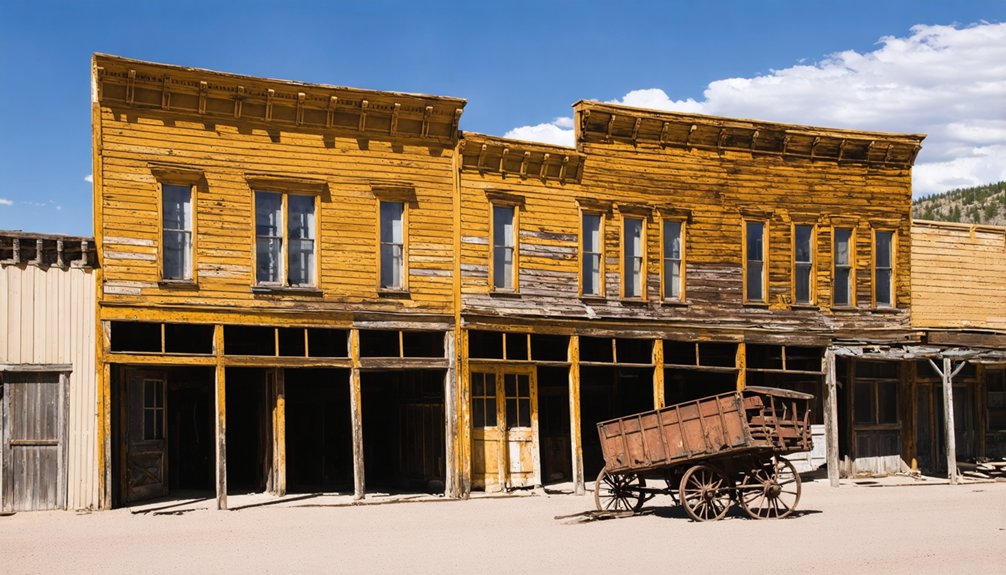
During Silver City‘s vibrant early years, life centered around the precious metal mines that brought fortune seekers to this Black Hills boomtown.
You’d find miners facing daily hazards, using dynamite and timber supports while working claims like the Diana Lode and Lady of the Hills mines.
When not underground, you’d join community gatherings at:
- The local Catholic church for spiritual guidance and social connection
- The general store and hotel, where miners shared tales of strikes and struggles
- Various saloons, where you could unwind after long days in the mines
Despite the rough frontier conditions, you’d experience a real sense of community as settlers established schools, hosted religious revivals, and worked together to build lasting institutions that would shape this mining camp’s character.
The Diana Lode Legacy
You’ll find the Diana Lode’s legacy woven into Silver City’s fabric through its mining infrastructure, which supported over 300 residents during the late 1870s boom period.
The Gorman brothers’ prospecting dreams ultimately went bust, yet their pioneering spirit laid the groundwork for Silver City’s transformation from a mining camp into an established community.
Today, you can still glimpse remnants of this mining heritage in the preserved buildings and cultural artifacts that tell the story of Black Hills mineral extraction and its impact on early South Dakota settlement.
Mining Operations and Infrastructure
The Diana Lode stands as one of Silver City’s foundational mining operations, marking the beginning of the town’s rapid growth in 1876.
You’ll find that mining challenges shaped the town’s infrastructure development, as the community faced critical resource shortages while building their frontier settlement.
Key aspects of Silver City’s mining operations included:
- The Black Hills & Western train, which provided essential transportation links
- Hydroelectric power solutions to address energy needs
- Stone quarrying operations that supported regional construction
The town’s rapid expansion to over 300 residents by 1878 demanded quick infrastructure solutions.
While you’d have witnessed the constant struggle for wood and fuel supplies, the mining community’s resilience led to innovative solutions like hydroelectric power consideration and strategic transportation development.
Prospecting Dreams Go Bust
Despite initial excitement surrounding its discovery in 1876, the Diana Lode’s legacy became a cautionary tale of unfulfilled mining dreams in Silver City.
You’ll find that, like many Black Hills operations, the mine yielded low-grade ore that couldn’t sustain long-term profits, especially when competing with the nearby Homestake Mine’s richer deposits.
As mining returns diminished, Silver City’s population dwindled, transforming from a bustling 300-resident boomtown into today’s ghost town.
While you can still spot remnants of mining nostalgia, including the post office that operated until 1964, the Diana Lode’s story mirrors countless Black Hills ventures that promised riches but delivered disappointment.
The remaining residents keep these memories alive, preserving a chapter of frontier ambition that shaped their community’s identity.
Cultural Impact and Remnants
While the Diana Lode’s economic potential faded, its cultural footprint left an indelible mark on Silver City’s identity.
You’ll still find traces of mining folklore and cultural traditions that shaped the town’s spirit, from tales of Tommyknockers – the mischievous mine spirits who demanded food offerings – to the preserved historic structures that stand as silent witnesses to the bustling mining era.
The Diana Lode’s legacy lives on through:
- The local historical society’s dedicated preservation of mining artifacts and stories
- Standing historic buildings that transport you back to the 1870s boom days
- Rich oral histories of mining conflicts and community life
These cultural remnants aren’t just relics – they’re the foundation of Silver City’s ghost town appeal, drawing history enthusiasts who seek to connect with the raw, pioneering spirit of the Black Hills’ mining heritage.
Railroad’s Arrival and Impact
During the early 1890s, Rapid City’s ambitious expansion into the Black Hills brought forth the Crouch Line railroad, fundamentally transforming Silver City’s destiny.
You’ll find the railroad’s initial construction reached Dark Canyon by 1893, with tracks extending to Mystic by 1906, marking a significant era of railroad expansion and economic growth for the region.
Yet the railroad’s story wasn’t without its struggles. In June 1907, devastating floods wreaked havoc on the infrastructure, destroying bridges and forcing major reconstructions.
Later that year, a tragic accident near Silver City claimed a fireman’s life when a burning bridge collapsed under a coal train.
Despite these challenges, the railroad proved indispensable to Silver City’s liveliness, bringing daily passengers, mail service, and essential transportation for mining outputs.
Daily Life in Early Silver City
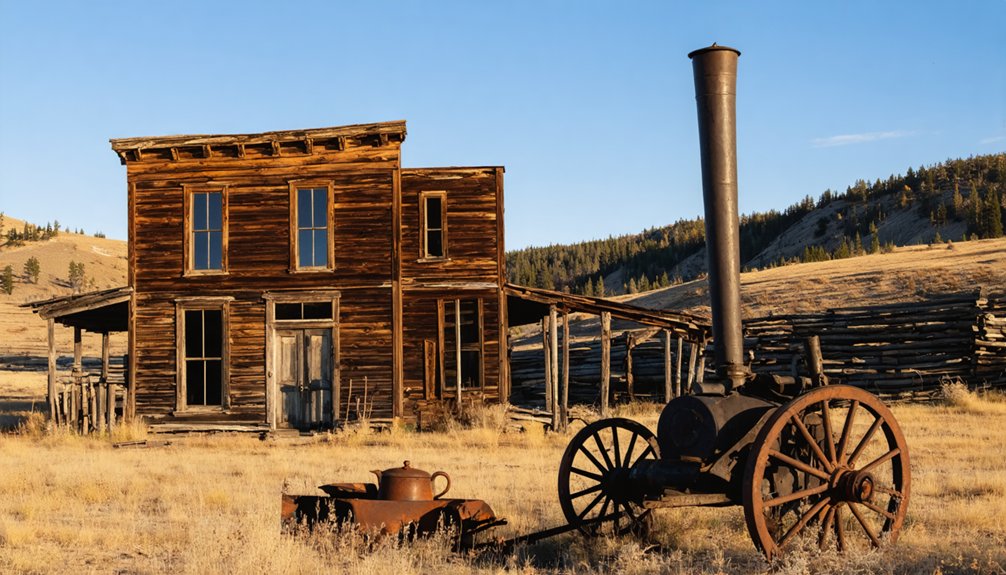
As the Gorman brothers established Silver City in 1876, they sparked a community that would soon bustle with over 300 residents by 1878.
You’d find daily life centered around mining operations, where experienced miners managed precious metals extraction while dealing with harsh living conditions and limited resources.
Social interactions revolved around these key community aspects:
- Saloons served as crucial gathering spaces where miners spent their earnings and formed bonds
- Trading and bartering became essential for resource management, helping residents secure necessities
- Community organizations and mining schedules created a tight-knit atmosphere despite occasional conflicts
Life wasn’t easy – you’d need to be resilient to handle the rudimentary housing, variable Black Hills weather, and isolation.
Yet the promise of mining wealth and the railroad’s lifeline kept the community’s spirit alive.
The Decline of Mining Operations
The vibrant spirit of Silver City’s early mining days began to fade in the late 19th century.
You’d have witnessed mounting mining challenges as low-grade ore deposits demanded more advanced milling techniques, while many claims failed to deliver their promised riches.
The Mystic Reduction Mill’s operational failures by 1913 signaled deeper troubles ahead.
Transportation setbacks hit hard when they discontinued the railroad stop, and you couldn’t ignore how the Great Depression struck another devastating blow to the area’s mining economy.
The mining community’s struggles intensified as timber resources dwindled and infrastructure crumbled.
Preservation of Historic Structures
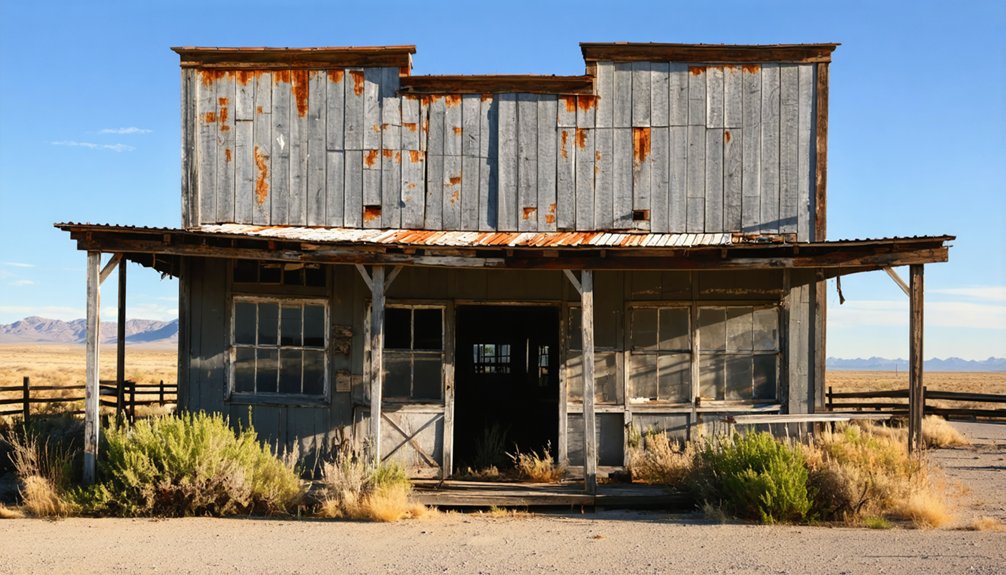
Since Silver City’s historic structures represent an invaluable link to its mining heritage, preservation efforts have gained momentum through dedicated community action.
You’ll find the historical significance of these buildings being safeguarded through initiatives like the CCC barracks relocation project, which showcases strong community involvement from local volunteers and the McLinn family.
- The Silver City Historical Society’s active preservation work guarantees these structures tell the story of the town’s mining and railroad legacy.
- Local grants and volunteer contributions have made it possible to overcome funding challenges in maintaining these historic treasures.
- Educational programs and tourism initiatives help sustain preservation efforts while raising awareness about Silver City’s rich past.
Despite environmental challenges and aging structures, your support of these preservation projects helps maintain authentic connections to Silver City’s frontier spirit.
A Recreational Haven Today
Modern visitors to Silver City will discover a thriving recreational destination that masterfully blends outdoor adventures with historical charm.
You’ll find endless outdoor activities at Pactola Lake, where you can rent boats, fish, or swim in pristine waters. For more adventurous spirits, Black Hills Outdoor Fun and D&K ATV Rentals offer thrilling guided and self-guided tours through rugged terrain.
The area’s natural wonders invite exploration, from Boston Hill’s panoramic views to wildlife spotting in the Gila Wilderness.
Community engagement flourishes through twice-weekly farmers’ markets on Bullard Street, while local art galleries and seasonal festivals keep the historic downtown buzzing.
Whether you’re staying at the historic Murray Hotel or camping under the stars, you’ll experience a perfect balance of wild freedom and small-town hospitality.
Frequently Asked Questions
What Happened to the Descendants of the Original Gorman Brothers?
You’ll find the Gorman legacy lives on through their descendants who shifted from mining to lumber, founding Gorman Bros. Lumber Ltd. Family stories reveal they’ve maintained properties while preserving their Christian values.
Were There Any Notable Crimes or Lawless Incidents in Silver City?
You’ll find Silver City’s crime history was remarkably peaceful, with one standout incident: the 1916 shooting between Ed Tuttle and L.A. Richards. Law enforcement wasn’t permanent, yet disorder remained minimal.
What Was the Average Silver Content Found in Local Mine Deposits?
You’ll find the silver mining deposits were remarkably rich, with ore quality showing a 40:1 silver-to-gold ratio in lode deposits and substantial argentite veins, though precise grades weren’t consistently documented.
Did Any Famous Historical Figures Ever Visit or Stay in Silver City?
You won’t find any famous visitors in town’s verified records. While local figures like the Gorman brothers shaped its historical significance, there’s no evidence that nationally-known personalities ever stayed here.
What Native American Tribes Inhabited the Area Before Silver City’s Establishment?
Like guardians of sacred ground, the Lakota (Sioux) and Cheyenne Native tribes primarily inhabited this region, with the Arikara having established their cultural heritage there earlier, around 1500 AD.
References
- https://www.silvercitysd.com/town
- https://www.everythingsouthdakota.com/silver-city-south-dakota/
- https://www.youtube.com/watch?v=Glucs_Rq8Xs
- https://www.sdpb.org/rural-life-and-history/2023-08-21/some-black-hills-ghost-towns-and-their-origins
- https://www.sdhspress.com/journal/south-dakota-history-2-2/some-black-hills-ghost-towns-and-their-origins/vol-02-no-2-some-black-hills-ghost-towns-and-their-origins.pdf
- https://ghostsofnorthdakota892857007.wordpress.com/2014/12/04/memories-silver-city-ghost-town/
- https://westernmininghistory.com/towns/south-dakota/silver-city/
- https://www.silvercitysd.com/home
- https://www.legendsofamerica.com/galena-south-dakota/
- https://www.sdhspress.com/journal/south-dakota-history-2-3/the-boom-and-bust-of-central-city/vol-02-no-3-the-boom-and-bust-of-central-city.pdf
